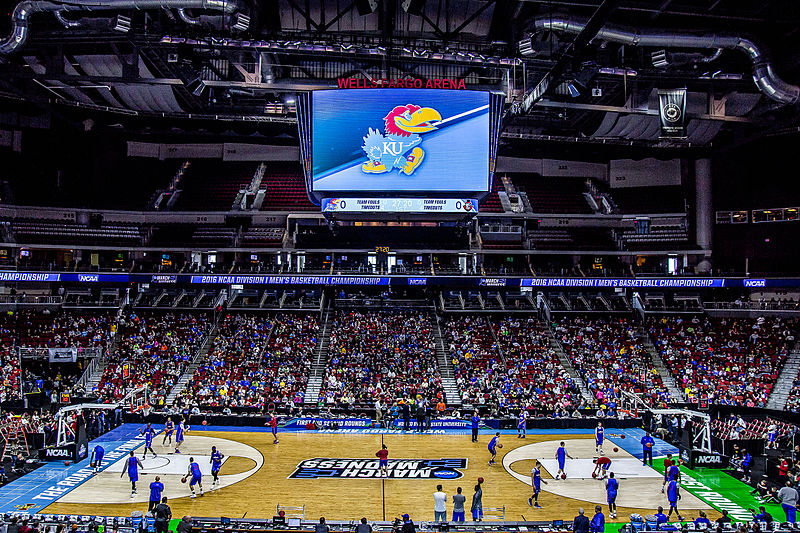If you’ve read any of my College Basketball articles up to this point, you’ll know that I consistently invoke a man named Kenneth Pomeroy, colloquially known as KenPom, for my sophomoric analysis. Pomeroy’s website, KenPom.com, is a predictive measure using statistics such as offensive efficiency, defensive efficiency, and strength of schedule to generate a relative efficiency margin for all 351 NCAA Division I Men’s basketball teams.
Among the most interesting components that KenPom takes into account is what he calls the “Four Factors”: effective field goal percentage, turnover percentage, offensive rebound percentage, and free throws to field goal attempts made. Win these four factors, which together comprise offensive efficiency, and according to KenPom, you have outstanding odds to win the game.
While making my March Madness bracket this year, I thought I would consult the Four Factors to see how each factor, when isolated, predicts this year’s results. I made it simple: In a given matchup, whichever team had a higher ranking of the factor moved on. I do not suggest making your picks off of any one of these factors, unless you want some strange looks from co-competitors. Without any further ado, here are the results:
Effective Field Goal Percentage:
Taking solely into account effective field goal percentage, we have a Final Four of No. 8 Creighton, No. 4 Gonzaga, No. 1 Villanova, and No. 1 Kansas. At first glance, this Final Four pairing doesn’t sound too crazy, with the exception of Creighton’s surprise inclusion in San Antonio. You may not win your bracket pool due to the chaos caused in earlier rounds, including one where No. 15 Georgia State upsets No. 2 Cincinnati, but you stand a fighter’s chance with bona fide picks in Gonzaga, Villanova, and Kansas, with the Wildcats taking the title.
Turnover percentage
Limiting turnovers is a key component of any tournament run. Just ask the 2017 North Carolina Tar Heels, who won the national championship largely due to a four turnover performance against Gonzaga. Strong shooting teams often have relatively poor offensive efficiencies, due to an alarming tendency to give the ball away. Accounting only for the lowest turnover percentage, our Final Four is No. 7 Nevada, No. 12 South Dakota State, No. 6 Florida, and No. 13 College of Charleston. Such a Final Four would feature the highest sum of seeds in NCAA Tournament history, with no favorites advancing to the sport’s biggest stage. You should take into account turnover percentage, but probably shouldn’t decide your picks solely off of that metric. The South Dakota State Jackrabbits capture their first NCAA title in this simulation, which likely will not come to fruition in the real tournament.
Offensive rebound percentage
Yet another component of offensive efficiency is offensive rebounds percentage. The more possessions you generate, the more opportunities you have to score. A high offensive rebound percentage can mitigate a so-so shooting percentage, as is evidenced by the high offensive ranking of teams like Duke and UNC. By far, offensive rebound percentage is correlated with the deepest tournament runs of past teams. In this year’s Big Dance, the teams that will advance to the Final Four based off of offensive rebound percentage are No. 2 Cincinnati, No. 2 North Carolina, No. 5 West Virginia, and No. 2 Duke. The final will feature the first-ever NCAA tournament meeting between North Carolina and Duke, with the Blue Devils taking the title. (If this catastrophic result holds, you won’t be hearing much more from me about college basketball).
Free throw rate
Last but not least is free throw rate, or the ratio of free throw attempts to field goal attempts. There are several elite teams this year, including Virginia, that thrive despite a low free throw rate, so look for an upset-filled bracket if you choose to roll with this factor. The Final Four in this case would be No. 5 Kentucky, No. 15 Lipscomb, No. 15 Cal State Fullerton, and No. 14 Bucknell, with Fullerton reigning as king of the Dance.
If you pick the mighty Titans over a field that includes Villanova, Duke, and Virginia, you’re on your own.
As you can see, KenPom statistics have their time and place for appropriate predictions. While it’s not advisable to make picks on the back of one factor, looking into each factor’s relative strength of prediction can help inform some of your decision-making. For example, offensive rebounding percentage is a great statistic for predicting winners, but free throw rate is not.
In the end, March Madness consists of the undeterred variable of chaos, far stronger than anything KenPom or any site puts out. There’s no “right” way to fill out a bracket, and anyone who tells you otherwise is lying. You’re best advised to sit back and enjoy the ride. Unless it involves Duke winning, of course.





